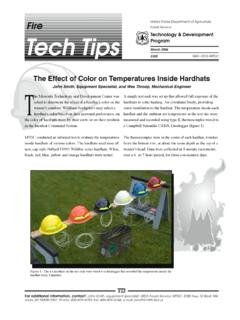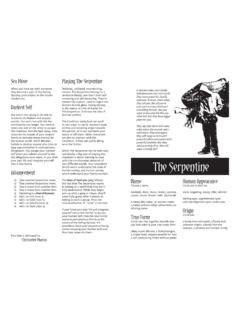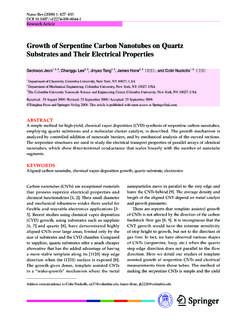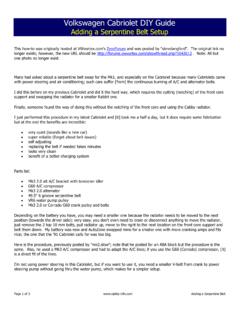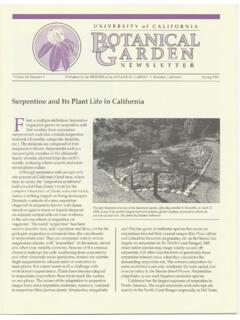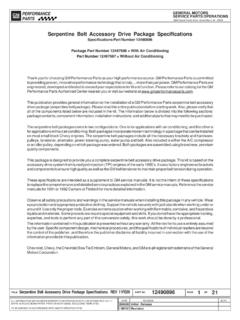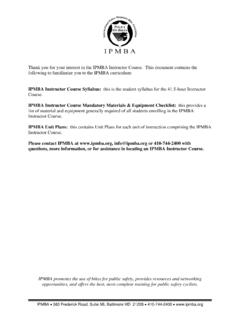Transcription of A DATABASE OF SERPENTINE AFFINITY - fs.fed.us
1 MADRON O, Vol. 52, No. 4, pp. 222 257, 2005 SERPENTINE ENDEMISM IN THE CALIFORNIA FLORA:A DATABASE OF SERPENTINE AFFINITYH. D. SAFFORD1,2, ,ANDS. P. HARRISON21 USDA-Forest Service, Pacific Southwest Region, 1323 Club Drive,Vallejo, CA of Environmental Science and Policy, University of California,Davis, CA 956163 Information Center for the Environment, DESP, University of California,Davis, CA 95616 ABSTRACTWe present a summary of a DATABASE documenting levels of AFFINITY to ultramafic ( SERPENTINE ) sub-strates for taxa in the California flora, USA. We constructed our DATABASE through an extensive literaturesearch, expert opinion, field observations, and intensive use of accession records at key herbaria. Wedeveloped a semi-quantitative methodology for determining levels of SERPENTINE AFFINITY (strictly endemic,broadly endemic, strong indicator , etc.) in the California flora. In this contribution, we provide a listof taxa having high AFFINITY to ultramafic/ SERPENTINE substrates in California, and present information onrarity, geographic distribution, taxonomy, and lifeform.
2 Of species endemic to California, arerestricted to ultramafic substrates. Most of these taxa come from a half-dozen plant families, and fromonly one or two genera within each family. The North Coast and Klamath Ranges support more serpentineendemics than the rest of the State combined. 15% of all plant taxa listed as threatened or endangered inCalifornia show some degree of association with ultramafic substrates. Information in our DATABASE shouldprove valuable to efforts in ecology, floristics, biosystematics, conservation, and land Words: SERPENTINE , ultramafic, California, endemism, rocks, often called SERPENTINE byecologists, botanists and pedologists, underlie morethan 6000 km2of the land area of the State of Cal-ifornia (Harrison et al. 2000). The edges of conti-nental plates often include bands of these vestigesof oceanic mantle rock, accreted during the geolog-ic process of subduction, and later uplifted and ex-posed during mountain building and subsequenterosion.
3 Ultramafic rocks and the soils that developon them are characterized by critically low levelsof most principal plant nutrients (N, P, K, Ca), andexceptionally high levels of Mg and Fe and a suiteof toxic trace elements including Cr, Ni, and of ultramafic rocks support high numbersof edaphic-endemic taxa throughout the world(Brooks 1987). The California SERPENTINE flora isthe richest in the temperate zone, and consists ofhundreds of species and subspecies that are largelyor entirely confined to ultramafic endemism is a key feature of the di-versity of the California flora (Raven and Axelrod1978; Kruckeberg 2002). Of about 1410 full spe-cies endemic to the State (Hickman 1993), Kruck-eberg (1984) estimated that about 180 were endem-ic to SERPENTINE . If these numbers are at least ap-proximately correct, then about 13% of the plantspecies endemic to California are SERPENTINE en-demics. This is a remarkably high number whenone considers that only of the State is under-lain by ultramafic rocks (6000 km2/406,280 km2).
4 In addition, because they tend to have small geo-graphic ranges and because many of them occur inthe rapidly urbanizing San Francisco Bay Area, ser-pentine endemics are overrepresented among thestate s rare, sensitive, and listed plant taxa (Skinnerand Pavlik 1994). The ecology of California s ser-pentine plants has been extensively studied at theUniversity of California s Sedgwick Ranch Reserve( , Seabloom et al. 2003; Gram et al. 2004) andMcLaughlin Reserve ( , Harrison et al. 2003;Safford and Harrison 2004) and Stanford Univer-sity s Jasper Ridge Reserve ( , McNaughton1968; Huenneke et al. 1990; Hobbs and Mooney1991).Botanists have relied for two decades on themonograph by Arthur Kruckeberg (1984) for mostof their information on Californian SERPENTINE -en-demic plant taxa. Since then, publication of the Jep-son Manual (Hickman 1993), and a proliferation ofnew botanical research and name changes have leftthis list in need of updating.
5 Our initial aim was tomodify Kruckeberg s (1984) list, primarily usinginformation from Hickman (1993), to use in ourresearch on diversity patterns (Harrison et al. 2000,2004). However, it soon became clear that wewould have to expand and intensify our search forthe best available information. Complicating thiseffort, plants show a continuum in degrees of ser-pentine restriction, and are sometimes more restrict-2005]223 SAFFORD ET AL.: SERPENTINE ENDEMISM IN THE CALIFORNIA FLORAed in some parts of their geographic ranges thanothers, thus contributing to inconsistencies amongreports from different sources. This led us to adopta semi-quantitative procedure for scoring plant taxaon their reported degree of SERPENTINE this contribution, we present a summary of ourcurrent DATABASE of SERPENTINE AFFINITY in the Cali-fornia flora. The DATABASE was constructed via anextensive literature search, expert opinion, field ob-servations, web research, and intensive use of ac-cession records at key herbaria.
6 It provides data onlevels of SERPENTINE endemism, rarity, geographicdistribution, taxonomy, and began by conducting a DATABASE search of theelectronic Jepson Manual (Hickman 1993) main-tained by the Jepson Herbarium at the Universityof California-Berkeley (UC-JEPS 2004a). The da-tabase was queried for all taxa with SERPENTINE , ultramafic , or related ( , asbestos soils ) ref-erences in the habitat description. Taxa containing non- SERPENTINE in the description were removedafterward. We cross-checked the 391 SERPENTINE -re-lated taxa found in the Jepson Manual with Kruck-eberg (1984), who listed those taxa he believed tobe endemic to ultramafic substrates in California,and those that were either local or regional ser-pentine indicators ( , nonendemic taxa whosedistributions are nonetheless skewed toward occur-rences on ultramafics). Taxonomic updates in theJepson Manual (Hickman 1993) were applied to theKruckeberg list (which included 377 taxa afterthese revisions), and then those taxa not on the Jep-son-derived list were added to our DATABASE .
7 Thisresulted in a list of 529 taxa; of these, 287 were notshared between the two sources. We then added tothe list a number of taxa that we considered to belikely endemics or indicators but which were notindicated as such by either Kruckeberg (1984) orthe Jepson Manual (1993). Finally, published lit-erature ( , Meinke and Zika 1992; Nelson andNelson 2004; Baldwin 1999 and 2001; Barkley1999; Porter and Johnson 2000; Zika et al. 1998)and the online Jepson Interchange Jepson FloraProject (UC-JEPS 2004b) were consulted for tax-onomic revisions and taxa newly described sincethe publication of the Jepson score the AFFINITY of taxa to ultramafic sub-strates, we adopted a modification of Kruckeberg smeasures of ultramafic fidelity . In his AppendixC, Kruckeberg (1984) used two or three 1 s tosignify increasing levels of endemism: three 1 swere attached to taxa with 95 100% of their oc-currences found on ultramafics, two 1 s signifiedtaxa with 85 94% fidelity.
8 In his Appendix D,Kruckeberg used one or two exclamation marks( ! s) to signify increasing levels of fidelity to ul-tramafic substrates among supposed nonendemic indicator taxa. In both appendices, questionmarks ( ? ) were attached to those taxa for whichmore information was necessary to confidently as-sign their status. Some of the tentative endemicswere included in the indicator appendix as well,thus these taxa occur twice in Kruckeberg s combined Kruckeberg s two scales, and addedtwo levels to yield six levels of ultramafic AFFINITY ,where 6 represents a strict endemic ($95% ofoccurrences on ultramafics), and successively lowervalues signify lower AFFINITY to the substrate (5585 94% of occurrences; 4575 84%; 3565 74%; 2555 64%; 1545 54%). By this defini-tion, 1 thus represents a species found about halfof the time on SERPENTINE . We consider scores be-tween 1 and 2 to indicate weak indicators , anda score of about 1 to mean an indifferent Kruckeberg fidelity scale crosswalks to ours inthe following fashion: 111 56; 11 55; !
9 ! 53; one ! 52. Those taxa which occurredin both Kruckeberg s endemic and indicator tableshad their two scores averaged: these all fell be-tween 3 and 4 on our scale. For example,Cu-pressus macnabianawas rated 111 in Kruck-eberg s Appendix C ( , 6 on our scale), and !! [ , 2 in our scale] in Appendix D; thesewere averaged to 4 on our attached our categorical levels of ultramaficaffinity to all of the species in our hybrid Jepson-Kruckeberg DATABASE . In the case of the Kruckebergtaxa, we simply cross-walked the Kruckeberg fi-delity codes to our scale as described above, mak-ing some adjustments based on more recent taxo-nomic revisions and combinations. In the case ofthe Jepson Manual taxa, we were forced to interpretthe language used in habitat descriptions to deter-mine levels of AFFINITY . We used the following in-terpretations of description language to assign af-finities: a 6 was assigned where the habitat de-scription categorically stated SERPENTINE or ul-tramafic (a 5 if there was some indication thatthis restriction was not absolute); a 4 was as-signed where the modifiers generally or usuallyserpentine were used; especially or often equaled 3 ; sometimes or occasionally equaled 1.
10 In a few cases, AFFINITY levels wereassigned based on ancillary information in the hab-itat and/or range description rather than on explicitstatement of SERPENTINE then conducted a broad survey of the litera-ture, regional botanical experts, and herbaria rec-ords to obtain as many sources as possible for eachtaxon in our DATABASE , and to add to the databaseany taxa we might have overlooked. We manuallyconsulted every species description in a variety ofregional and local floras (Clifton 2001; Ertter andBowerman 2004; Howell 1970; McMinn 1939; Os-wald 2002; Smith and Wheeler 1992), and guide-books to rare and sensitive taxa (Hanson 1999;Hoover et al. 1993; Jimerson et al. 1995; McCarten1988; McCarten and Rogers 1991; Nakamura andNelson 2001; Trinity SIPS 2001; USFWS 1998).224[Vol. 52 MADRON OWe also consulted the CalFlora Online Species Da-tabase (CalFlora 2004), and the California NativePlant Society Online Inventory of Rare and Endan-gered Plants (CNPS 2004).]







